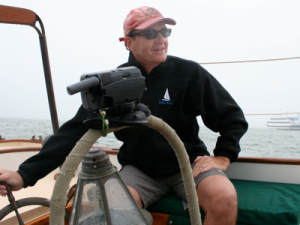 I found out what I was in for the minute I met Tupelo Honey’s Captain Don Benoit. “I need a dollar bill,” he said. As he took the bill in one hand and shook mine with the other, I got the punch line: “Congratulations, you’re my first paying customer.” He called to his crew Prescott to put the bill aside for framing.
I found out what I was in for the minute I met Tupelo Honey’s Captain Don Benoit. “I need a dollar bill,” he said. As he took the bill in one hand and shook mine with the other, I got the punch line: “Congratulations, you’re my first paying customer.” He called to his crew Prescott to put the bill aside for framing.
My introduction to the boat was much more indirect. On the first morning of my family’s Boston vacation in June, I spotted her from the deck of my cousin’s condo in the Boston Naval Yard. A classic sailboat motoring by during what turned out to be the few fleeting moments of sunshine during our otherwise rain-sodden visit. I could read the name from pictures I took of her: Tupelo Honey. A sign for Tupelo Honey tours on the guard shack at the next pier provided the contact information I needed to get onboard.
Tupelo Honey is a replica 31-foot Friendship Sloop, a design that originated in Friendship, Maine, around 1880 as a fishing boat. Tupelo Honey’s deep blue hull is fiberglass, but it has exquisitely-maintained wooden spars. According to Captain Don, the mast is a tree trunk taken from the Essex River. The boom for the mainsail extends beyond the transom while the tacks for the jib and staysail are well forward on the bowsprit. The hull and sail shapes produce an elegant silhouette that suggests a much longer boat. (Tupelo Honey is measured in the 1880 way; 31 feet is the length at waterline and excludes the huge overhangs.)
On Wednesday, June 24, I went out with Captain Don and Prescott aboard Tupelo Honey for a cruise that added to my sailing vocabulary. Two halyards raise the throat and the peak of the gaff-rigged mainsail. The halyards are made fast to belaying pins and Prescott moved forward on the bobstay and bowsprit shroud to remove the jib sail ties.
The Inner Harbor was an impressionistic canvas with fog and rain blurring the lines and muting the colors. With the sails up, Tupelo Honey headed southwest on port tack, built speed, and settled in at 6+ knots. We glided past the eerily-quiet downtown and toward the cargo cranes in South Boston. Rain fell. Wind blew. Captain Don turned the wheel over to me.
Even though a wheel is supposed to make it “like driving a car,” I had to overcome my tendency to treat the wheel like a tiller and turn the wheel to port when I wanted to fall off to starboard and vice versa. After mentioning this to Captain Don (who otherwise might have wondered if I had ever driven a car), I held Tupelo Honey on course and started to get a feel for the boat. A Coast Guard boat passed astern, a lobster boat checked a trap, and the full-keel Tupelo Honey sailed on with an easy motion through the chop and gusts.
On the return leg, Castle Island, the home of Fort Independence, became a spectral presence. A church spire materialized in downtown Boston out of the fog. The towers and cables of the Zakim Bridge—a product of the Big Dig—appeared incongruously futuristic over the Charles River.
To the eyes of a desert dweller, the low clouds shrouded Boston in an almost magical fog that made everything more immediate. The cruise on Tupelo Honey was a perfect counterpoint to the sun-drenched sailing we take for granted in Arizona. The rain created a sense of solitude that otherwise would have been impossible on a sunny day in the busy commercial harbor of a major East Coast city.
Sailing Tupelo Honey was, well, sweet. It provided a much-needed sailing fix during a non-sailing family vacation and was a great way to see the harbor, the city, and a new charter business taking its first steps toward what I hope will be a long and successful run. There are plenty of tour boats ferrying customers around the harbor. There is only one Tupelo Honey.